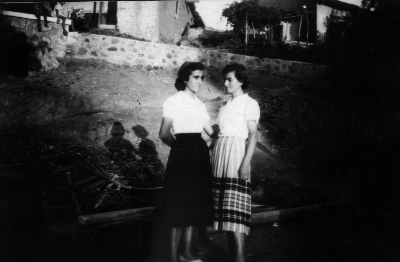Quilt No.778SI - Stavroula Ioannou

2000 x 1800mm
Made by a local quiltmaker (name unknown) on the island of Cyprus in 1959. Sent to Australia shortly after. Always owned by Stavroula Ioannou.
"Stavroula's Two Quilts
Unlike many other migrants of the time, Stavroula came to Australia by air in 1959, but her two paplomata (quilts) arrived a little later by boat. Stavroula's mother, Efpraxia, anxious that her daughter's prika (dowry) be complete in true Greek tradition even in faraway Australia, purchased the locally-grown raw cotton and the satin and cotton fabrics, and then arranged for the local 'paplomatas' (quiltmaker) to come to their house, in their village of Evrychou, in the district of Lefkosia.
Although she was not in Cyprus when her own quilts were made, Stavroula remembers the 'paplomatas' coming to their house at other times; she recalls how he would assemble the 'paploma' - laying out one layer of fabric, turning the edges like a wide hem, fluffing up the raw cotton with a 'doxari'. 'it's like a large boomerang with a string across it; he would hit it with another piece of wood and the cotton would all fluff up, it seemed to fill the whole house. He would then spread the raw cotton evenly, place the other layer of fabric over and stitch around the edges first, to hold everything in place; then go to the centre, using a very large needle, to begin quilting the pattern. Everyone designs and stitches differently,' she muses.
The island of Cyprus, now an independent republic, has a long and troubled, political history. In those days high school education was not an option for most Cypriot families, so from age eleven, while her parents ran a mixed business Stavroula worked in the family-owned fields (horafia) where they grew olives, grapes, apples, potatoes and other vegetables. The family was certainly not poor, but with four daughters and three sons, her parents had considerable financial responsibilities, particularly with the girls who each needed a dowry, which often included a house, in order to get married.
Stavroula came to Australia and joined her brother and sister in Newtown, Sydney. She began work as a dressmaker and in 1961 married Phoebus, who also had come from Cyprus; they lived in Woollahra. After 16 years they moved to their present house in Bellevue Hill, where to this day the floral quilt is their main bedcover; and the pink satin quilt is often called into service when visitors arrive. Originating in the ancient 'Island of Aphrodite', these two quilts are fulfilling their destiny of usefulness and decoration, in an even more ancient 'antipodes' land!
Stavroula and Phoebus have two sons, John, a secondary maths teacher, and Kim, a nuclear medicine technologist. He and his wife Stamatina have two children, Ilia and Phoebus."
[Written by Lula Saunders; adapted from interview 2/1/01 for the National Quilt Register]



Related Quilts:
2465 x 2057mm
585 x 509mm
1400 x 1150mm
2000 x 1820mm






